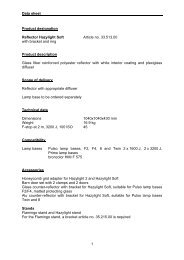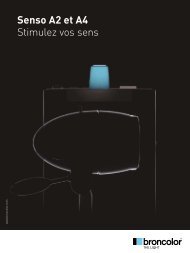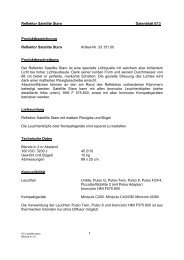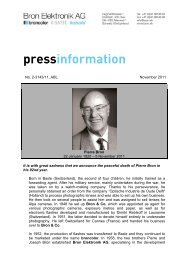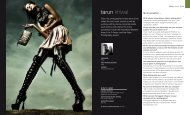Read the complete interview with Bronek Kozka.
Read the complete interview with Bronek Kozka.
Read the complete interview with Bronek Kozka.
You also want an ePaper? Increase the reach of your titles
YUMPU automatically turns print PDFs into web optimized ePapers that Google loves.
Interview <strong>with</strong> <strong>Bronek</strong> <strong>Kozka</strong> <strong>the</strong> winner of <strong>the</strong> broncolor award 2010<br />
By Chris Anderson<br />
<strong>Bronek</strong> <strong>Kozka</strong> lives and works in Melbourne Australia. <strong>Kozka</strong>'s ongoing involvement is in arts education.<br />
He is a lecturer at <strong>the</strong> Royal Melbourne Institute of Technology (university), lecturing in photography<br />
and portraiture. His commercial photographic practice forms <strong>the</strong> basis for his art practice<br />
and his investigation of <strong>the</strong> portrayal of remembered moments.<br />
<strong>Kozka</strong> has exhibited in several group shows and award/prize shows; <strong>the</strong>se include <strong>the</strong> National<br />
Portrait prizes of both <strong>the</strong> Australian (2007+2009) and UK (2008) Albury Art Prize (highly commended),<br />
SCAP08 (commended) Scap09, Monash Gallery of Art Award (2008+2009) and <strong>the</strong> Hasselblad<br />
Masters Award 2008. <strong>Kozka</strong>'s solo show includes "Picturing Community: Ugunja, Kenya"<br />
(2002), "Auschwitz Revisited" (2005) and "The Best Years of Our Lives" (2009). <strong>Kozka</strong> was also<br />
invited to exhibit a solo show at <strong>the</strong> Grand Prix International de Photographie de Vevey/Switzerland<br />
in September 2010, winning <strong>the</strong> broncolor Award for lighting. Running in <strong>the</strong> same month,<br />
<strong>Kozka</strong>’s work was also shown at <strong>the</strong> Pingyao International Photo Festival in China, at which he<br />
was honoured <strong>with</strong> an award as an international participant.<br />
In 2008 two series of <strong>Kozka</strong>’s work were published in <strong>the</strong> Hasselblad Masters Book Vol.1, <strong>the</strong>y<br />
were “Sunshine House” & “Passion”. In 2010 <strong>Kozka</strong>’s work was featured in <strong>the</strong> Australian publication<br />
(Book), Hijacked: Australian & German Photography.<br />
<strong>Kozka</strong>’s work is held in several private collections in Australia and internationally. He is represented<br />
by Bett Gallery Hobart & MARS Gallery in Melbourne, Australia.<br />
- Are you mainly working in your studio or do you shoot on location as well?<br />
“I have a studio in Melbourne, Australia. The studio environment is very important to me. It is not<br />
only <strong>the</strong> place where I create some of my elaborate scenes but it is also an important creative hub.<br />
I have four o<strong>the</strong>r photographers working from my studio, we are a diverse group whose passion<br />
for art and photography is common.” And <strong>Kozka</strong> continued his explanation:<br />
“Location shooting is very much part of what I do, this is especially true for exhibition work. In<br />
highly lit locations, my photographs become ‘home’ to a cast of actors and models who act out a<br />
series of stories created from storyboards. From a man and woman driving a car, a confrontation<br />
outside a suburban home, a cleaning lady resting in a quiet room, to a woman and her two children<br />
watching TV in a nondescript living room. These stories are assembled from fragments of fi lm<br />
references, o<strong>the</strong>r people’s experiences of spaces <strong>the</strong>y inhabit, and my own memory of spaces I<br />
have inhabited previously.<br />
Through <strong>the</strong>se elaborate tableaux photographs, I am interested in exploring <strong>the</strong> construction of<br />
memory, shared spaces we inhabit as human beings and <strong>the</strong> psychological tensions that can arise<br />
from sharing <strong>the</strong>se spaces. I portray ‘memory’ by playing on <strong>the</strong> ambiguity of fact and fi ction in<br />
our ability to recall a scene or happening. These photographs are a partly truth and partly myth<br />
concept, exploring how memory can confuse, and also assure one’s construct of a story. There is<br />
uncertainty in <strong>the</strong> photographs between whe<strong>the</strong>r it is night or day, dream or reality and fi lmic references<br />
are utilised to create a dark, and at times depraved, construct of <strong>the</strong> shared spaces we<br />
inhabit. So fi nding <strong>the</strong> right location is often <strong>the</strong> key to a successful image.”
- What is <strong>the</strong> most common kind of photographic work you are shooting in your studio?<br />
My work has always been quite varied as I use my art practice as a major part of my folio and new<br />
work is often related (stylistically) to what I am showing in <strong>the</strong> folio. My clients range from graphic<br />
design fi rms and advertising agencies through to certain charity/welfare organisations. Then <strong>the</strong>re<br />
is my art practice and academic side. I actively exhibit through Australian commercial galleries; I’m<br />
also exhibiting in public galleries too. Linked <strong>with</strong> exhibition work is my academic side; I’ve recently<br />
<strong>complete</strong>d a MA (masters), very similar to US MFA (exhibition and exegesis) and will be embarking<br />
on a PhD next year.<br />
- What are <strong>the</strong> typical trends of photography in general in your country? What are <strong>the</strong> trends in<br />
your photographic work?<br />
“Photography is at an interesting cross roads. I guess this is nothing new as <strong>the</strong>re are always new<br />
directions, but I think <strong>the</strong> combination of a changing landscape for <strong>the</strong> industry and new technology<br />
- not just to capture but also for <strong>the</strong> delivery and internationalisation of markets -all means we<br />
are entering a new era. My feeling is <strong>the</strong> photographer of <strong>the</strong> future has to be a visually literate,<br />
and socially aware commentator to an even greater degree than in <strong>the</strong> past.”<br />
- Where do young people get <strong>the</strong> education to become photographers in your country?<br />
“Melbourne is very fortunate to be <strong>the</strong> home of <strong>the</strong> Royal Melbourne Institute of Technology University.<br />
Our Design and Communication School is one of <strong>the</strong> largest in <strong>the</strong> sou<strong>the</strong>rn hemisphere<br />
and is where <strong>the</strong> BA Photography course is located. Lecturers are from commercial, fi ne art and<br />
documentary backgrounds, and <strong>the</strong> course also has a strong academic and <strong>the</strong>oretical element.<br />
There are also Honours, Masters and PhD avenues that can be pursued. I have been lecturing in<br />
this course for 8 or 9 years, over <strong>the</strong> years I have seen <strong>the</strong> course change and develop, responding<br />
to new developments in <strong>the</strong> industry. We also have a very vibrant community of international<br />
students from Europe (several Swiss students over <strong>the</strong> years), Asia and <strong>the</strong> USA.”<br />
- Are you shooting exclusively <strong>with</strong> digital cameras or when would you use analog cameras? Do<br />
you have a favourite camera and lens? If so for what particular reason?<br />
I pretty much exclusively shoot digitally, very occasionally I will shoot 10 x 8 for a personal project.<br />
I shoot a Hasselblad H series camera for ease and versatility. The Hasselblad <strong>with</strong> 50 to 110 zoom<br />
or 120mm lens. I have been shooting <strong>the</strong> Hasselblad since I became a Hasselblad Master in 2008.<br />
I cannot fault this camera, it always delivers and <strong>the</strong> results are very impressive.<br />
- For how many years are you working <strong>with</strong> broncolor lighting?<br />
When I was studying, broncolor was always <strong>the</strong> gold standard, <strong>the</strong> best. It was Hasselblad cameras<br />
and broncolor lighting. Being introduced to broncolor at Uni was great. My shooting requires<br />
many different types of lighting; one shoot will soon be entirely lit <strong>with</strong> huge balloon lights that generally<br />
are used only at major night time road works. But when it comes to fl ash equipment broncolor<br />
has always been my fi rst choice.<br />
Asked why he is using broncolor as his fl ash lighting, <strong>Bronek</strong> <strong>Kozka</strong>’s answer came as quick as a<br />
shot: “The quality.”<br />
- What broncolor equipment is in your possession and what is your favourite light / light shaper?<br />
I use broncolor Mobil units, Grafi t A4s, and sometimes broncolor monolights. Recently I used <strong>the</strong><br />
broncolor Scoro; <strong>the</strong>y are all great !
I use so many different ones for different applications, sometimes it is a large honeycomb, but<br />
sometimes <strong>the</strong> best thing in <strong>the</strong> world is a piece of cardboard and a pair of scissors….every day is<br />
different.<br />
- Where do you see photography in <strong>the</strong> future? Do you have some experience <strong>with</strong> „crossover“ still<br />
to video photography? Could you share some experience <strong>with</strong> our readers?<br />
“Well, <strong>the</strong> equipment we use will change and keep changing, photography is about communicating<br />
ideas that will not change. Photographers need to be fl exible and willing to embrace new methods<br />
and modes of communication.” And <strong>Bronek</strong> <strong>Kozka</strong> continued:<br />
“While video is new and very interesting, and yes I am exploring its possibilities, so much of <strong>the</strong><br />
discussion seems to revolve around <strong>the</strong> technical aspects, <strong>with</strong> little to no discussion about how<br />
to produce a good or great piece of communication. A fantastic still image spread over 24 frames<br />
a second for 30 seconds does not equal a great video. This is something that has been seen in<br />
peoples “home video” for years, a great sunset shot in <strong>the</strong> family album is not so great when it’s a<br />
video that runs for 2 minutes! As photographers, we have <strong>the</strong> ability to capture a <strong>complete</strong> narrative<br />
in 1/60 of a second, video requires that same narrative to unfold over time.”<br />
- Tell us about your next project, please.<br />
“My next project is a series of very large-scale scenes, still playing <strong>with</strong> <strong>the</strong> idea of memory but on<br />
a larger scale, we are more obviously viewers in this new series.”<br />
“Thank your very much for your time and sharing your work <strong>with</strong> our readers.”<br />
<strong>Bronek</strong> <strong>Kozka</strong><br />
The Bakehouse Studio<br />
2/133-135 Johnston Street,<br />
Collingwood, Victoria, 3066<br />
Australia<br />
T: ++61 3 94173456<br />
www.kozka.com






